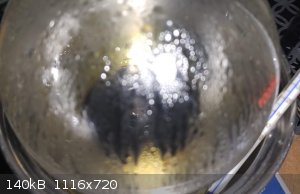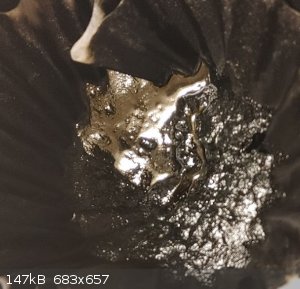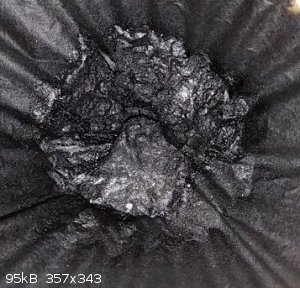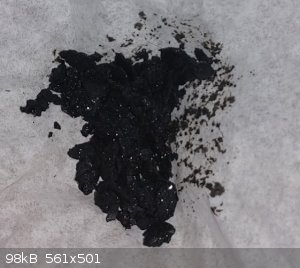night429
Harmless

Posts: 49
Registered: 12-11-2019
Member Is Offline
Mood: 
|
|
My attempt at the Skraup quinoline synthesis
A few months ago, I got the idea to do the Skraup synthesis. The general procedure I followed was the 8-hydroxyquinoline synthesis outlined in Vogel's
Practical Organic Chemistry on page 1186, but I scaled it way down and changed the o-nitrophenol and o-aminophenol with equimolar amounts of
nitrotoluenes and p-aminophenol, respectively. This was because the latter two were significantly easier to obtain than the former two.
To start, I weighed out 5.6g of recrystallized and light-brown p-aminophenol, which was made from paracetamol, and added it to a plastic cup. To this,
I added 14.3g of glycerin (most likely not anhydrous as it's over a year old), followed by slow additions of 93% sulfuric acid, amounting to 9mL. This
was extremely exothermic (as one might expect), and I made sure the temperature never exceeded 80°C. The final color was a grayish, and it was very
viscous. In a flask, I added 0.6g of crystalline ferrous sulfate heptahydrate and 3.7g of nitrotoluenes. I then put the flask in an oil bath with a
small stirbar and started heating. Once the temperature got up to 100°C, I started to add the p-aminophenol goo in small portions.
I kept adding it in small amounts, but I realized I wasn't heating it hot enough. So, I let the oil bath heat up to 135°C, then continued with
additions, which spanned 1 hour 45 minutes. The solution at this point was a reddish-brown. Afterwards, I kept it at this temperature or above and
stirred for an additional 4 hours. In the meantime, I dissolved 12.7g of sodium hydroxide in 15mL of water, which was placed in the freezer to cool.
About 2 hours in, the color was very dark, with a yellow-orange around the edges. At the end, I took it out of the oil bath and let it cool. It was a
viscous orange/black liquid, and the smell coming off of it was similar to a mix of nitrotoluenes and methyl ethyl ketone, which I thought was odd.

I slowly added the sodium hydroxide solution, which caused the solution to tar up. I attempted to keep the temperature below 40°C, but the small
stirbar I had and the increasing viscosity made it very difficult, and I had to resort to manually stirring it with the thermometer. Once all of it
was added, I filtered off the precipitate and washed the flask with a bit of ice-cold water. There was a small amount of tar left in the flask, which
was easily gotten rid of with HCl. In the filter was a black substance that smelled like a mixture of nitrotoluenes and the pesticide area of a
hardware store.

I let it filter overnight.

The next day, I put it in my toaster oven to dry. It melted at first, but eventually solidifed after extended heating. When I took it out, I saw that
there was a mixture of crystals and a black substance. So, I took it out and transferred it to a new coffee filter.

This is where I deviate from Vogel and the procedure takes a nosedive; seeing as though I can't purify by distillation like Vogel (I don't have a
vacuum pump and the boiling point of the 6-hydroxyquinoline is above sulfuric acid's), I tried steam-distillation and recrystallization from acetone
and water. None worked. This at least disproves it being p-aminophenol freebase, as that's insoluble in water. The smell of the final product was like
before, but without the nitrotoluenes: somewhat like naphthalene, but sweeter in a way and less "dry". My thermometer also didn't measure up to the
melting point, 195°C, so I couldn't characterize it that way either. So, I gave up with purification at this point.
Because this synthesis is quite cheap, I want to revisit this synthesis at some point in the future, but I want to scale it up. That way, I can really
test out purification techniques in bulk. I also don't have enough iodine to use as an oxidizer, so I'm pretty much locked into using nitroaromatics.
I know the Skraup synthesis produces side products that are very difficult to separate, but I'm curious if the phenolic hydroxyl group would make it
easier. Possibly an acid/base extraction? Let me know what you think.
We can't live forever
|
|
|
Fery
International Hazard
    
Posts: 1052
Registered: 27-8-2019
Location: Czechoslovakia
Member Is Offline
|
|
Hi night429, very nice!
So you got a mixture of quinoline and 6-hydroxyquinoline both with methyl group in some position? Maybe they could be separated by converting phenolic
compound into Na salt and extracting it into water phase while quinoline stays in organic phase?
What do you mean that steam distillation did not work? Was your product neutral at steam distillation phase? If acidic then pyridine ring bound as a
salt, if alkaline then phenolic group bound as a salt, but then at least (methyl)quinoline should distill
Pity that you are over the ocean. I have o-nitrophenol more than I need and I'm planning a synthesis like you did (quinoline from nitrobenzene +
aniline + glycerol and 8-hydroxyquinoline from o-nitrophenol + o-aminophenol + glycerol) although I already have both products (commercial reagents).
Then I plane to oxidate quinoline into corresponding dicarboxylic acid (quinolinic acid = pyridine-2,3-dicarboxylic acid).
|
|
|
night429
Harmless

Posts: 49
Registered: 12-11-2019
Member Is Offline
Mood: 
|
|
Quote: Originally posted by Fery  | Hi night429, very nice!
So you got a mixture of quinoline and 6-hydroxyquinoline both with methyl group in some position?
|
Thanks Fery! I honestly have no idea. I think I primarily have just 6-hydroxyquinoline with tar as a side product, which is causing the black color. I
can't imagine that the phenol got reduced to a benzene or a methyl group got added. Unless some stuff reacted with the nitrotoluenes or I'm clueless
about side products.
Quote: Originally posted by Fery  |
Maybe they could be separated by converting phenolic compound into Na salt and extracting it into water phase while quinoline stays in organic phase?
What do you mean that steam distillation did not work? Was your product neutral at steam distillation phase? If acidic then pyridine ring bound as a
salt, if alkaline then phenolic group bound as a salt, but then at least (methyl)quinoline should distill
|
That's a good idea, kinda a reverse extraction where you pull out the stuff you don't want with nonpolar. I'll have to give it a shot. I don't recall
the specifics of the steam-distillation since I did this back in May, and the pH may have been acidic/basic, but I'm not sure. I remember only trace
nitrotoluene coming over, which remained as an oil. I think the hydroxyl group messes up steam-distillations via hydrogen bonding.
Quote: Originally posted by Fery  |
Pity that you are over the ocean. I have o-nitrophenol more than I need and I'm planning a synthesis like you did (quinoline from nitrobenzene +
aniline + glycerol and 8-hydroxyquinoline from o-nitrophenol + o-aminophenol + glycerol) although I already have both products (commercial reagents).
Then I plane to oxidate quinoline into corresponding dicarboxylic acid (quinolinic acid = pyridine-2,3-dicarboxylic acid).
|
That's cool, and best of luck to you on those procedures! Do you have any plans for the quinolinic acid? I think I vaguely remember you talking about
looking into the structure of the anhydrides. Also, yeah, o-nitrophenol would be very nice to have. The o-aminophenol that can be derived from it
seems useful as well. Does it oxidize in air as easily as p-aminophenol? I feel like my p-aminophenol goes from off-white to a light brown within the
span of a couple weeks.
We can't live forever
|
|
|
Fery
International Hazard
    
Posts: 1052
Registered: 27-8-2019
Location: Czechoslovakia
Member Is Offline
|
|
night429 I will try the reduction in future and will report how stable is o-aminophenol, I'll have to prepare circa 3 esters and then I will continue
in organic chemistry of nitrogen, so far I did only reductions of nitrobenzene, 25 years ago into aniline and this month to azobenzene and
azoxybenzene. The next to do in my plans are oxidation of trinitrotoluene and decarboxylation into trinitrobenzene and then these Skraup quinoline
syntheses. Luckily I have plenty of commercial quinoline and 8-hydroxyquinoline so I can do melting tests with the 8-hydroxyquinoline I'll obtain and
compare boiling points of commercial quinoline with the obtained product by me. And so far I do not yet have more ideas what to do with nitrogen
organic compounds. Yes and the oxidation of quinoline with hot 10% water KMnO4 solution as you mentioned (I did it with naphthalene 30 years ago).
|
|
|
night429
Harmless

Posts: 49
Registered: 12-11-2019
Member Is Offline
Mood: 
|
|
Alright, thanks! I'm looking forward to hearing of the results of your Skraup and trinitrotoluene procedures.
I wonder if one could make various o-substituted pyridine derivatives from the quinolinic acid. If the anhydride is, in fact, similar to phthalic
anhydride, it seems theoretically possible to produce the cyclic di-amide, followed by Hoffman degradation and catalytic decarboxylation to form
2-aminopyridine, which can then undergo the Sandmeyer reaction to produce various derivatives. Although, I could be overlooking something.
We can't live forever
|
|
|
|